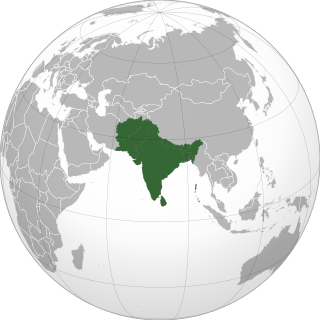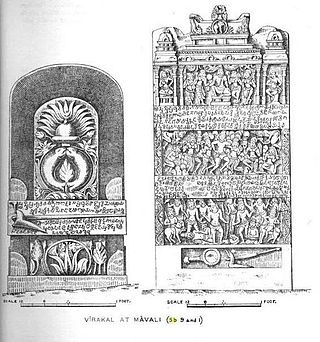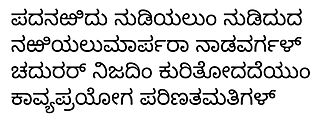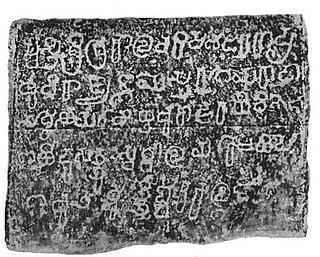Related Research Articles

The middle kingdoms of India were the political entities in the Indian subcontinent from 230 BCE to 1206 CE. The period begins after the decline of the Maurya Empire and the corresponding rise of the Satavahana dynasty, starting with Simuka, from 230 BCE. The "middle" period lasted for almost 1436 years and ended in 1206 CE, with the rise of the Delhi Sultanate, founded in 1206, and the end of the Later Cholas.

The Kingdom of Mysore was a realm in southern India, traditionally believed to have been founded in 1399 in the vicinity of the modern city of Mysore. From 1799 until 1950, it was a princely state, until 1947 in a subsidiary alliance with British India. The British took Direct Control over the Princely State in 1831. It then became Mysore State with its ruler remaining as Rajapramukh until 1956, when he became the first Governor of the reformed state.
Dantidurga, also known as Dantivarman II was the founder of the Rashtrakuta Empire of Manyakheta. His capital was based in Gulbarga region of Karnataka. His successor was his uncle Krishna I who extended his kingdom to all of Karnataka.

Amoghavarsha I was the greatest emperor of the Rashtrakuta dynasty, and one of the most notable rulers of Ancient India. His reign of 64 years is one of the longest precisely dated monarchical reigns on record. Many Kannada and Sanskrit scholars prospered during his rule, including the great Indian mathematician Mahaviracharya who wrote Ganita-sara-samgraha, Jinasena, Virasena, Shakatayan and Sri Vijaya.

Rashtrakuta was a royal Indian dynasty ruling large parts of the Indian subcontinent between the sixth and 10th centuries. The earliest known Rashtrakuta inscription is a 7th-century copper plate grant detailing their rule from manapur a city in Central or West India. Other ruling Rashtrakuta clans from the same period mentioned in inscriptions were the kings of Achalapur and the rulers of Kannauj. Several controversies exist regarding the origin of these early Rashtrakutas, their native homeland and their language.
Govinda II was an emperor of the Rashtrakuta Empire after Krishna I.

Govinda III was a famous Rashtrakuta ruler who succeeded his illustrious father Dhruva Dharavarsha. He was militarily the most successful emperor of the dynasty with successful conquests-from Kanyakumari in the south to Kannauj in the north, from Banaras in the east to Broach (Bharuch) in the west. He held such titles as Prabhutavarsha, Jagattunga, Anupama, Kirthinarayana, Prithvivallabha, Shrivallabha, Vimaladitya, Atishayadhavala and Tribhuvanadhavala. From the Someshvara inscription of 804 it is known that Gamundabbe was his chief queen. Govinda III was undoubtebly the ablest of the Rashtrakuta emperors, unrivalled in courage, generalship, statesmanship, and martial exploits.The Rashtrakutas would reach their absolute peak under his rule.

Kavirajamarga is the earliest available work on rhetoric, poetics and grammar in the Kannada language. It was inspired by or written in part by the famous Rashtrakuta King Amoghavarsha I, and some historians claim it is based partly on the Sanskrit text Kavyadarsha. Some historians believe Kavirajamarga may have been co-authored by a poet in the king's court, the Kannada language theorist Sri Vijaya.

Dhruva was one of the most notable rulers of the Rashtrakuta Empire. He ascended the throne after replacing his elder brother Govinda II. Govinda II had become unpopular among his subjects on account of his various misconducts as a ruler, including excessive indulgence in sensual pleasures. This according to the historian Kamath is evident from the Karhad plates of Krishna III. The Dhulia grant of 779 and Garugadahalli inscription of 782 proclaim Dhruva the emperor. Though some historians claim that Dhruva revolted and grabbed the throne, other historians feel the transition of the throne from Govinda II to Dhruva was peaceful and may have happened willingly. He earned titles like Kalivallabha, Srivallabha, Dharavarsha, Maharajadhiraja and Parameshvara.

Tailapa II, also known as Taila II and by his title Ahavamalla, was the founder of the Western Chalukya dynasty in southern India. Tailapa claimed descent from the earlier Chalukyas of Vatapi, and initially ruled as a Rashtrakuta vassal from the Tardavadi-1000 province in the modern Bijapur district of Karnataka. When the Rashtrakuta power declined following an invasion by the Paramara king Siyaka, Tailapa overthrew the Rashtrakuta king Karka II, and established a new dynasty.
The Origin of the Rashtrakuta dynasty has been a controversial topic and has been debated over the past decades by historians. The differing opinions mostly revolve around issues such as the home of the earliest ancestors of the medieval Rashtrakutas, a possible southern migration during the early part of the first millennium and the relationship between the several Rashtrakuta dynasties that ruled small kingdoms in northern and central India and the Deccan in the 6th century - 7th century. Further, the relationship of these medieval Rashtrakutas to the most important and famous dynasty, the Rashtrakutas of Manyakheta of the 8th century - 10th century time period has also been debated. Also contested is whether the Rashtrakutas of Manyakheta were related by ancestry to the early Kannada, Maratha, Reddi communities of the Deccan or other ethnic groups of northern India.

Krishna I, an uncle of Dantidurga, took charge of the growing Rashtrakuta Empire by defeating the last Badami Chalukya ruler Kirtivarman II in 757. This is known from the copper plate grant of Emperor Govinda III of 807 and a copper plate grant of the Gujarat Rashtrakuta Emperor Karka from Baroda. He is also known as Kannara or Kannesvara and took the titles Akalavarsha, Shubatunga, Prithvivallabha and Shrivallabha. He patronised the famous Jain logician Akalanka Bhatta, the author of Rajavartika.
Krishna II ascended the Rashtrakuta throne after the demise of his famous father Amoghavarsha I Nrupatunga. His Kannada name was Kannara. His queen was a Haihaya princess of Chedi called Mahadevi. From the chronology of inscriptions that mention the name of this king, it seems Krishna II may have started to rule even during the lifetime of his father. The fact that Amoghavarsha in his last years renounced the affairs of the state in religious pursuits supports this claim. The rule of Krishna II saw significant advances in literature, although in the affairs of expansion of the empire, his reign was mixed. During his reign he cultivated matrimonial alliance with Chedis to form military gain.
Indra III was the grandson of Rashtrakuta Krishna II and son of Chedi princess Lakshmi. He became the ruler of the empire due to the early demise of his father Jagattunga. He had many titles such as Nithyavarsha, Rattakandarapa, Rajamarathanda and Kirthinarayana. He patronised Kannada poet and commander SriVijaya and Sanskrit poet Trivikrama. Indra III was married to princess Vijamba of the Kalachuri dynasty of central India (Chedi).
Govinda IV was the younger brother of Amoghavarsha II. He became the Rashtrakuta emperor in 930 as described in the Kalasa record of Chikmagalur. He was a very unpopular ruler who indulged in licentious acts. Control over Kannauj was lost during his rule. The Chalukyas of Vengi defeated him and much territory was lost. Finally, his own feudatories including King Arikesari of Vemulavada in Andhra revolted against him and placed Amoghavarsha III on the throne in 935. This is known from the records of Kannada poet Adikavi Pampa, who was patronised by King Arikesari. Govinda IV had matrimonial relationship with the Cholas of Kanchi and finally found refuge with them when his feudatories revolted. Govinda IV patronised Kannada poet Ravinagabhatta.

Krishna III whose Kannada name was Kannara was the last great warrior and able monarch of the Rashtrakuta dynasty of Manyakheta. He was a shrewd administrator and skillful military campaigner. He waged many wars to bring back the glory of the Rashtrakutas and played an important role in rebuilding the Rashtrakuta empire. He patronised the famous Kannada poets Sri Ponna, who wrote Shanti purana, Gajankusha, also known as Narayana, who wrote on erotics, and the Apabhramsha poet Pushpadanta who wrote Mahapurana and other works. His queen was a Chedi princess and his daughter Bijjabbe was married to a Western Ganga prince. During his rule he held titles such as Akalavarsha, Maharajadhiraja, Parameshvara, Paramamaheshvara, Shri Prithvivallabha etc. At his peak, he ruled a vast empire stretching from the Narmada river in the north to the Kaveri river delta in the south. A copper grant of 993 issued by the Shilahara king of Thana claims the Rashtrakuta control extended from the Himalayas in the north to Ceylon in the south and from the eastern sea to the western seas. The grant states that when King Krishna III mobilised his armies, the kings of Chola, Bengal, Kannauj, Andhra and Pandya regions used to quiver.
Ponna (c. 945) was a noted Kannada poet in the court of Rashtrakuta Dynasty king Krishna III (r.939–968 CE). The emperor honoured Ponna with the title "emperor among poets" (Kavichakravarthi) for his domination of the Kannada literary circles of the time, and the title "imperial poet of two languages" for his command over Sanskrit as well. Ponna is often considered one among the "three gems of Kannada literature" for ushering it in full panoply. According to the scholar R. Narasimhacharya, Ponna is known to have claimed superiority over all the poets of the time. According to scholars Nilakanta Shastri and E.P. Rice, Ponna belonged to Vengi Vishaya in Kammanadu, Punganur, Andhra Pradesh, but later migrated to Manyakheta, the Rashtrakuta capital, after his conversion to Jainism.

Rashtrakuta literature is the body of work created during the rule of the Rastrakutas of Manyakheta, a dynasty that ruled the southern and central parts of the Deccan, India between the 8th and 10th centuries. The period of their rule was an important time in the history of South Indian literature in general and Kannada literature in particular. This era was practically the end of classical Prakrit and Sanskrit writings when a whole wealth of topics were available to be written in Kannada. Some of Kannada's most famous poets graced the courts of the Rashtrakuta kings. Court poets and royalty created eminent works in Kannada and Sanskrit, that spanned such literary forms as prose, poetry, rhetoric, epics and grammar. Famous scholars even wrote on secular subjects such as mathematics. Rashtrakuta inscriptions were also written in expressive and poetic Kannada and Sanskrit, rather than plain documentary prose.
The political history of medieval Karnataka spans the 4th to the 16th centuries, when the empires that evolved in the Karnataka region of India made a lasting impact on the subcontinent. Before this, alien empires held sway over the region, and the nucleus of power was outside modern Karnataka. The medieval era can be broadly divided into several periods: The earliest native kingdoms and imperialism; the successful domination of the Gangetic plains in northern India and rivalry with the empires of Tamilakam over the Vengi region; and the domination of the southern Deccan and consolidation against Muslim invasion. The origins of the rise of the Karnataka region as an independent power date back to the fourth-century birth of the Kadamba Dynasty of Banavasi, the earliest of the native rulers to conduct administration in the native language of Kannada in addition to the official Sanskrit. This is the historical starting point in studying the development of the region as an enduring geopolitical entity and of Kannada as an important regional language.
Kambarasa also known as Stambha, was a member and prince of the Rashtrakuta dynasty. He was the eldest and first son of Dhruva Dharavarsha his illustrious father, and was given the governorship of the region of Gangavadi. He had always longed for the Rashtrakuta throne in his youth, and wanted the throne for himself after his father's death, but was defeated by his younger brother, Govinda III, but was spared by him, and once more was allowed to govern Gangavadi.